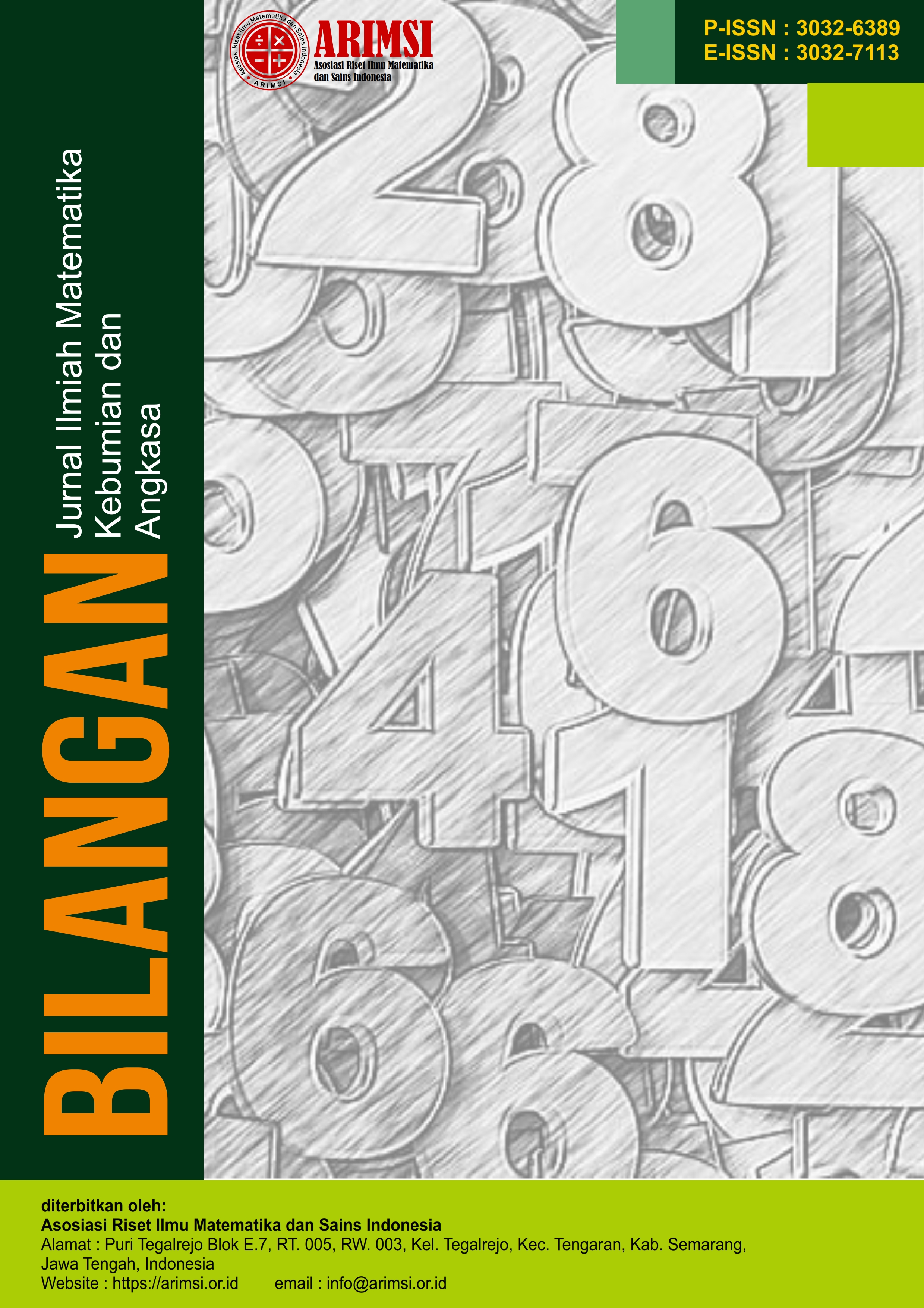Studi Literatur: Pentingnya Berpikir Komputasional dalam Meningkatkan Kemampuan Pemecahan Masalah Matematis Peserta Didik
DOI:
https://doi.org/10.62383/bilangan.v2i2.36Keywords:
Computational Thinking, Computational Thinking and Problem SolvingAbstract
Computational Thinking is a way of thinking that refers to the ability to solve problems using concepts used in computing. Computational thinking is a way of thinking in solving problems that students must develop in the digital era. This research aims to examine the importance of computational thinking in improving students' mathematical problem solving abilities. The type of research used is qualitative research using a literature study approach in the form of books, notes, journals, reports of relevant research results, as well as the results of observations. The results of the analysis show that it is very important for students to have computational thinking in order to improve their mathematical problem solving abilities. Computational thinking involves solving problems using a logical and systematic mindset that involves selecting and using algorithms, data representation, problem decomposition, abstraction, pattern recognition and hypothesis testing. Computational thinking has become an important and essential skill for humans in the 21st century. Educators must advocate the importance of integrating learning with computational thinking concepts into the educational curriculum. Computational thinking has an important role in learning. This can be useful for improving mathematical problem solving abilities. Apart from that, computational thinking can also develop critical, creative and analytical thinking skills in solving complex problems, both in the context of computing and everyday life.
Downloads
References
Ansori, M. (2020a). Pemikiran Komputasi (Computational Thinking) dalam Pemecahan Masalah. Dirasah, 3(1), 2621-2838.
Ansori, M. (2020b). Penilaian Kemampuan Computational Thinking (Pemikiran Komputasi). SALIMIYA: Jurnal Studi Ilmu Keagamaan Islam, 1(2), 176-193.
Barr, V., & Stephenson, C. (2011). Bringing Computational Thinking to K-12: What is Involved and What is the Role of the Computer. Science Education Community, 2 (1). 450-454.
Bilbao, dkk. (2017) . Assessment of Computational Thinking Notions in Secondary School. Baltic Journal of Modern Computing, 5 (4). 140-144.
Bouck, E.C., Sands, P., Long, H., dan Yadav, A. (2021). Preparing Special Education Preservice Teachers to Teach Computational Thinking and Computer Science in Mathematics. Teacher Education and Special Education: The Journal of the Teacher Education Division of the Council for Exceptional Children, 44 (3), 221 - 238. doi: https://dx.doi.org/10.1177/0888406421992376
Cahdriyana, R. A., & Richardo, R. (2020). Berpikir Komputasi dalam Pembelejaran Matematika. LITERASI (Jurnal Ilmu Pendidikan), 11(1), 50.
Christi, N.R Sabinus & Rajiman Widyawati. (2023). Pentingnya Berpikir Komputasional dalam Pembelajaran Matematika. Journal on Education, 05 (04). 12590-12598.
Hasyim, dkk. (2019) . Analisis High Order Thinking Skill (Hots) Siswa Dalam Menyelesaikan Soal Open Ended Matematika. Jurnal Pendidikan Matematika Dan Matematika, 5 (1). 337-348
Julianti, dkk. (2022). Computational Thinking Dalam Memecahkan Masalah High Order Thinking Skill Siswa, Prosiding Seminar Nasional MIPA UNIBA. 1-7.
Megawati, T. Annas, dkk. (2023). Implementasi Computational Thinking dalam Pembelajaran Matematika di Sekolah Dasar. Jurnal Review Pendidikan Dasar: Jurnal Kajian Pendidikan dan Hasil Penelitian, 9 (2), 96-103.
Mustafa. (2023). Aktivitas Siswa dalam Memecahkan Masalah Matematika dengan Berpikir Komputasi Berbantuan Chat-GPT. Mathema Journal, 5(2), 283-298
Nasiba, Umu. (2022). Brankas Rahasia : Media Pembelajaran Numerasi Berbasis Berpikir Komputasi Untuk Meningkatkan Kemampuan Pemecahan Masalah. Jurnal Didaktika Pendidikan Dasar. 6(2), hal 521-538
Putri Rahma Dwi Riska, dkk. (2022). Pentingnya Keterampilan Abad 21 dalam Pembelajaran Matematika, SICEDU: Science and Education Journal, 1(2), 449-459.
Rich, K. M., Yadav, A., & Schwartz, C. V. 2019. Computational Thinking, Mathematics, and Science: Elementary Teachers’ Perspectives on Integration. Jl. of Technology and Teacher Education, 27 (2). 541-546.
Rohman, dkk. (2020). Kemampuan Pemecahan Masalah Matematika Model TIMSS Konten Bilangan pada Siswa dengan Kecerdasan Logis-Matematis Rendah dan Sedang. Konferensi Nasional Penelitian Matematika dan Pembelajarannya (KNPMP) V. 173- 190.
S. A., Rahman. (2013). Peningkatan Kemampuan Pemecahan Masalah, Berpikir Reflektif Matematis dan Adversity Quotient Siswa SMP dengan Pendekatan Open-Ended. Bandung : Universitas Pendidikan Indonesia.
Safik, M. (2022). Integrasi Computational Thinking dalam Pembelajaran Matematika di Madrasah Ibtidaiyah. Ibtida’: Media Komunikasi Hasil Penelitian Pendidikan Guru Madrasah Ibtidaiyah, 03(02), 241-248.
Sukamto, T. S., Pertiwi, A., Affandy, A., Syukur, A., Hafidhoh, N. U., & Hidayat, E. Y. (2019). Pengenalan Computational Thinking Sebagai Metode Problem Solving Kepada Guru dan Siswa Sekolah di Kota Semarang. Abdimasku: Jurnal Pengabdian Masyarakat, 2(2), 99-107.
Susanti, R. D., dan Taufik, M. Analysis of Student Computational Thinking in Solving Social Statistics Problems. Supremum Journal of Mathematics Education, 5(1), 22-31.
Veronica, dkk. (2022). Hubungan Berpikir Komputasi dan Pemecahan Masalah pada Pembelajaran Matematika di Sekolah Dasar. Jurnal Ilmiah Pendidikan Matematika, 05 (01). 96-103.
Wing, J. M. (2006). Computational Thinking . COMMUNICATIONS OF THE ACM, 49(3), 33-35.
Zakaria, Effandi. (2007). Trend Pengajaran dan Pembelajaran Matematik, Kuala Lumpur : Lohprint SDN,BHD
Downloads
Published
How to Cite
Issue
Section
License
Copyright (c) 2024 Bilangan : Jurnal Ilmiah Matematika, Kebumian dan Angkasa

This work is licensed under a Creative Commons Attribution-ShareAlike 4.0 International License.





